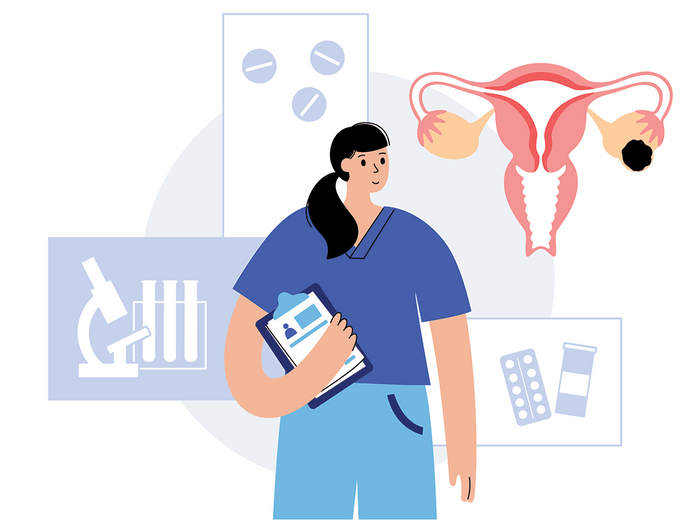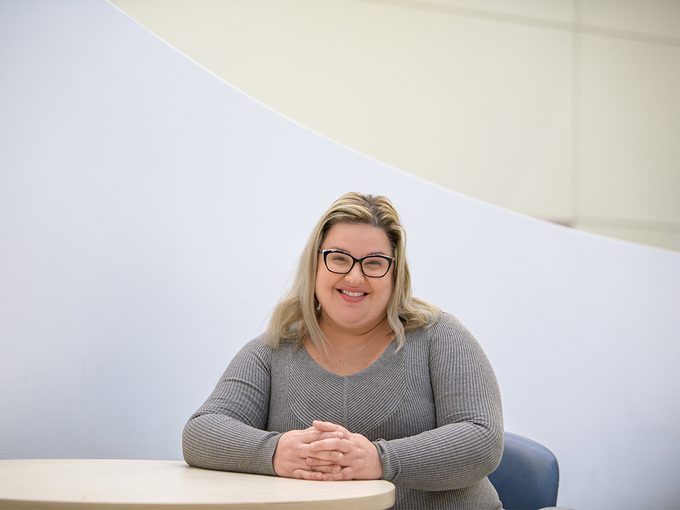What’s the Deal with Ovarian Cysts?

Everyone who ovulates has them—but few of us know what they’re all about.
“The ultrasound found ovarian cysts,” I texted my friends in a WhatsApp group. It was 2014, I was in my mid-twenties, and I had gone off the pill to discover an irregular period. My friends wrote back instantly—one said she also had them and was diagnosed with polycystic ovarian syndrome. One said she was worried about whether hers would burst. Another said she had several, and asked if we, too, had been told they looked like raisins (we had not).
Over the next decade, after a few ultrasounds and in my current stint as a health editor, I’ve learned that ovarian cysts are not only incredibly common but also come in different forms. Some cysts are small and shrivelled; others can grow to the size of a baby. Some sit there politely and some aggressively rupture. Some are elegantly called “string of pearls,” while others have hair and teeth. Here’s what else I’ve learned: We’re all incredibly confused about these many forms, why ovarian cysts are there in the first place and what we should do about them.
“Ovarian cyst is a really broad term used for anything that grows within the ovary or even next to it,” says Michelle Jacobson, a gynecologist at Women’s College Hospital in Toronto. “Traditionally, cysts have been defined as fluid-filled sacs, but now we know they could also be filled with tissue or septations, which are compartments of fluid.” She explains that the most common cysts are benign ones called follicles that occur during ovulation. “In normal menstrual cycles, a follicle grows an egg each month, and when the egg matures, the follicle releases it,” she says. The empty follicle sac then shrinks and produces hormones to prepare for the next egg. In this case, cysts are a good thing—they’re essential for reproduction. But as my friends and I know, some cysts have to be monitored, some are painful and some muck up your menstrual cycle.
After my most recent ultrasound, I was told I don’t have a cyst anymore—just many follicles. What happened? And how many variations of cysts are there? How can they impact our health? Jacobson breaks it down for us.

How many types of cysts are there?
There are a lot. It’s not even within somebody’s scope to know all of the different kinds of ovarian cysts. They come from all sorts of different tissue origins, which is how we characterize them.
Where do they come from?
That’s dependent on the kind of cyst. But in general, it has to do with fluid or material that gets trapped or extruded into another compartment. So in a follicular cyst, which is the most basic one that develops during ovulation, it contains the fluid that surrounds the egg.
Should we be concerned about any cyst beyond the ones during ovulation?
There are many types of benign cysts. You can have other variances that are not part of normal ovarian function, but are not necessarily cancerous. Those cysts can have blood in them, either because blood has ruptured into a cyst or filled with old blood, like if you’ve been diagnosed with endometriosis.
To name a few benign cysts: There are ones called fibromas that grow out of solid fibrous tissues, which look a lot like a solid tumour or a hard tissue. There are ones called dermoid cysts that are made up of different tissue lines and can have body parts like teeth and hair. And there are polycystic ovaries, in which ovaries have lots of little follicles—they’re called “string of pearls”—that have never produced an egg but can grow into a full-sized egg within the ovary.
Wait—some cysts have teeth and hair?
Yes, but not everybody who has them knows that they do. They’d only know if they had an ultrasound so we could see the different types of tissue in them, or if we follow them to see if the cyst grows or changes in a concerning way. But rarely do they have to be removed.
And what about the string of pearls? Is that worrisome?
In a normal menstrual cycle, women will recruit many follicles, even though only one usually becomes the dominant—or lead—follicle that ovulates. So it’s quite normal to have lots of little follicles at any given time in a normal menstrual cycle. But in polycystic ovarian syndrome (PCOS) or polycystic ovaries (PCO), you get lots of little cysts that might have immature eggs in them, but haven’t had the signal to go on to ovulate and don’t necessarily have a lead follicle. There’s still a bit of a mystery around why some women get PCOS and others don’t.
Why are some cysts bad?
Some people have a cyst that causes pain, which can be due to a number of reasons, like if the cyst is extremely large—it might be pressing on different anatomy. They can also twist and cause an ovarian torsion, which means the blood supply to the ovary has been cut off, and that’s extremely painful and can lead to the loss of an ovary. Cysts can also cause pain by rupturing. They can leak fluid or blood into the peritoneal or abdominal cavity, which is irritating to the tissue. Some sizable cysts may need to be removed because they’re impeding fertility.
If a patient carries a genetic mutation or has a family history of ovarian cancer, there’s a higher chance that a suspicious cyst is cancerous. We don’t know if it’s cancer or pre-cancer until it’s removed and sent to the pathologist. So a small, suspicious, asymptomatic cyst might be removed because we want to know what it is and if there’s any additional treatment that needs to happen.
Do cysts ever go away on their own or are they with you for life?
That depends. Some of them will regress on their own, like a follicular cyst, which is an egg containing a sac. But both endometriomas, cysts made of old blood, and dermoids, made out of solid tissue, do not tend to go away on their own. If they’re causing discomfort they can be removed.
What do we still not know about ovarian cysts?
There’s a lot we don’t know about how cysts become cancer, and specifically ovarian cancer. I could say that’s because women have traditionally not been the focus of research, but also, it’s hard to develop studies to understand this. It’s hard to do research on tissue, and especially in reproductive-age women, where we’re not taking ovaries out. You’re not getting autopsy specimens to do research on young women. So there’s just not a lot of opportunity. And ovaries are complicated.
If there was a way to know if a cyst was cancerous and to pick up ovarian cancer early, that would be a huge gamechanger for the world. We can’t screen for it, pick it up early with an ultrasound or MRI, or blood test—so we can’t find it early. It’s usually not seen until it’s too late.
Next: ‘We’re Not Doing a Good Enough Job’: How Canada’s Health Gap Is Affecting Women




